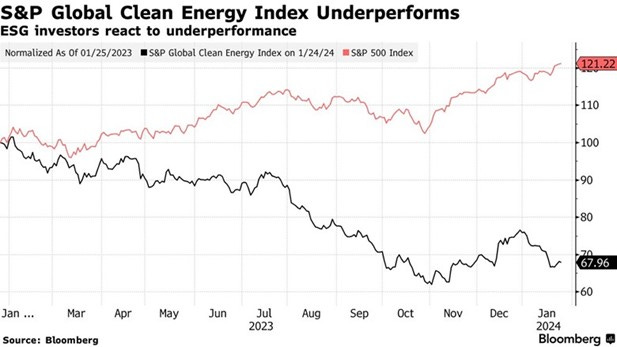Energy Musings - February 1, 2024
Investing in ESG funds has just experienced its first-ever net withdrawals. The geographical flows are interesting and show Europe's continued embrace of its green energy strategy.
Europe’s Green Investors Still Believe, But For How Much Longer?
Last week, investment research firm Morningstar reported that for the first time ever, net global investment outflows were experienced by environmental, social, and governance (ESG) funds. What was interesting was the geographical breakdown of the investment fund flows for the final three months of 2023. They would seem to reflect a shifting focus towards ESG funds by investors.
In the U.S., ESG fund clients withdrew $5.1 billion according to the Morningstar analysis. Japanese clients pulled out $1.2 billion from their ESG funds. The combined total of net withdrawals exceeded the $3.3 billion of net inflows to European ESG funds. Morningstar says its analysis included funds with investment strategies claiming to focus on sustainability, impact, or ESG.
Across all geographical regions with ESG-oriented funds, 2023’s fourth quarter saw a net withdrawal of $2.5 billion. These investment trends have multiple explanations. First, there has been a growing questioning of the validity of the ESG strategy, most particularly in the U.S. It has been a politically divisive issue, with Republics often questioning whether the ESG focus is part of the “woke” and anti-capitalist movement. Democrats tend to be strong supporters of ESG investing to save the world.
A second and more troubling issue for ESG investments has been that the strategy is not clear and consistent. Does it mean ESG funds will not own shares in fossil fuel companies? Reviews of some ESG funds showed they owned these stocks. What other sectors present challenging issues for their inclusion or exclusion? They often fall into the “sin” stocks such as tobacco, alcohol, gambling, adult entertainment, and weapons. However, a study several years ago showed the significant amount of money the California pension funds missed by banning investments in tobacco stocks at the height of the anti-smoking movement.
The first-ever net withdrawals from ESG funds also coincide with a very poor performance of “clean energy” investments. The chart below demonstrates how the S&P Global Clean Energy Index has underperformed the overall market beginning early in 2022. Last year was marked by various challenges for clean energy investments. Most notable was the impact of inflation, supply chain issues, and higher interest rates on the profitability of renewable energy companies. These economic headwinds also impacted consumer discretionary spending.
ESG investment flows suggest issues with the strategy which are also reflected in the poor performance of clean energy stocks.
The most interesting point from Morningstar was the difference in performance between the actively managed ESG funds and the passive ones. The biggest managers of ESG products – Parnassus Investments, BlackRock, Inc., Amundi SA, and UBS Group AG – are having a difficult time bringing in money to actively managed funds, but are still getting passive inflows. The Morningstar analysis showed that Europe’s positive net inflow came because the funds received $21.3 billion in money for passive funds against an outflow of nearly $18 billion from actively managed ESG funds. This adds to the never-ending debate over the value versus cost of active versus passive money management.
The investment flows seem to confirm that investors – residents – in Europe are still willing to put their money where their mouths are by continuing to back ESG investment strategies. It seems a little incongruous given the multiple protests by farmers in countries across the continent over plans for cuts in diesel subsidies, increased green regulations, delays in European Union payments for sustainable agricultural practices, and welcoming cheap food and agricultural imports.
European governments experiencing farmer protests are dealing with them differently. In Germany, the farmer protest problem has been compounded by a court decision that the government’s repurposing of the €60 ($66) billion left over from a Covid-19 fund to finance the green agenda was unconstitutional. That meant the government suddenly had a hole in its budget, which prompted it to cut energy subsidies among other spending adjustments. Germany continues to direct its attention to overcoming the fuel impact from Russia’s natural gas shutoff and the need to find replacement supplies in the form of LNG, which means constructing new LNG import terminals. Finding the money is making its efforts more difficult.
In France, the government has agreed to drop plans to gradually reduce diesel subsidies. It has also been announced that the agriculture department would provide €230 ($250) million in additional subsidies to wine producers. And now the European Union, the focal point of the farmer protests, has agreed to delay for one year the implementation of its rule on biodiversity and soil health, which required farmers to sequester 4% of their land for non-productive purposes.
The Guardian, a climate change alarmist newspaper in the U.K., wrote yesterday that “The protests are the latest episode in a growing political backlash which has been brewing for months to the European green deal. Now, with European elections looming and the far right on the rise in several member states, green groups fear efforts to weaken environmental rules are meeting less and less resistance.”
The commentary was published in an article headlined “‘Hypocritical’ European politicians weaken climate policies amid farmer protests.” The paper’s European environment correspondent authored the article. It highlights the growing pushback by the non-elites of Europe to the green policies of governments driven by the political and social agendas of the elites on the continent. Will this pushback impact ESG investment inflows in Europe, as we are seeing in the U.S. and Japan? So far, that doesn’t appear to be the case but stay tuned.




